Malvella
Recently, it seems there has been confusion on iNaturalist between Malvella lepidota and M. leprosa. The differences between these two are not all that straightforward as can be read in the comments below. Most treatments include a combination of leaf-shape and hair characteristics. The characteristics, however, have many seemingly intermediate forms. This is especially problematic in the Lubbock area where many different forms can be found, though few truly reach M. lepidota.
Before I go further, there are two main hair types that need defining. One is a silvery, scaly, bead-like (lepidote) hair and the other is a shaggy hair with many branches from a central point (stellate). In addition to these, there are various intermediate hairs called sub-lepidote hairs. The type specimen of M. lepidota has lepidote and sub-lepidote hairs and leaves defined by a broad base that abruptly tapers to a long (almost as long as broad) lanceolate and acute apex. The type specimen of M. leprosa has lepidote to sub-lepidote hairs and a leaf shape that is broad and rounded with no apical process. The shallow lobes are rounded unlike many of the Texas plants. Perhaps the only difference in hairs between the two types is that the hairs are often sparse along the veins of M. lepidota and uniform in M. leprosa, but even this is inconsistent. Also, M. lepidota includes a slightly wider diversity of hairs with the sub-lepidote hairs becoming close to stellate while those of M. leprosa are more uniformly between lepidote and short sub-lepidote. The sepals of the two are slightly different. In the type of M. lepidota, they are lanceolate. In the type of M. leprosa, they are closer to ovate. This could be helpful, but it seems that most of the observations have sepals that are closer to lanceolate. The type of M. leprosa is from Cuba, so it is expected that there might be some geographic differences. However, this means that sepals aren't as taxonomically stable. The Flora of North America treatment also includes the folding of the sepals where they meet each other, but I haven't really been able to tease much out that is consistent. In the type specimens, this information is not preserved. I may try to look into it again but will focus on other characteristics for now.
All of what I discussed above makes things very difficult when trying to identify. Unless the sepal characteristic is viable, the main characteristic we must use is leaf shape. This is somewhat unpredictable as can be seen below. Gradation is not entirely complete, but close to it. Perhaps the closest distinction one can make in leaf shape is in the appearance of the leaf apex appearing as a separate lobe (i.e., added on to the base of the leaf similar to the first photo of M. lepidota or the apical leaves of the second photo of M. lepidota). This is not fully satisfactory as the young leaves in the second photo labeled as M. lepidota has broad leaves without this appearance.
Going back to hair-type, there are four main plant forms.
- stellate throughout. This was known as M. herbacea or M. leprosa var. herbacea.
- stellate on undersides of leaves, stems, and sepals; sub-lepidote or lepidote otherwise. This is M. leprosa, but differs from the type. Perhaps some odd morphs of M. lepidota (according to FNA)?
- lepidote and sub-lepidote hairs only. Includes M. leprosa (the type) and M. lepidota (the type).
- lepidote hairs only. Includes M. lepidota and M. sagittifolia
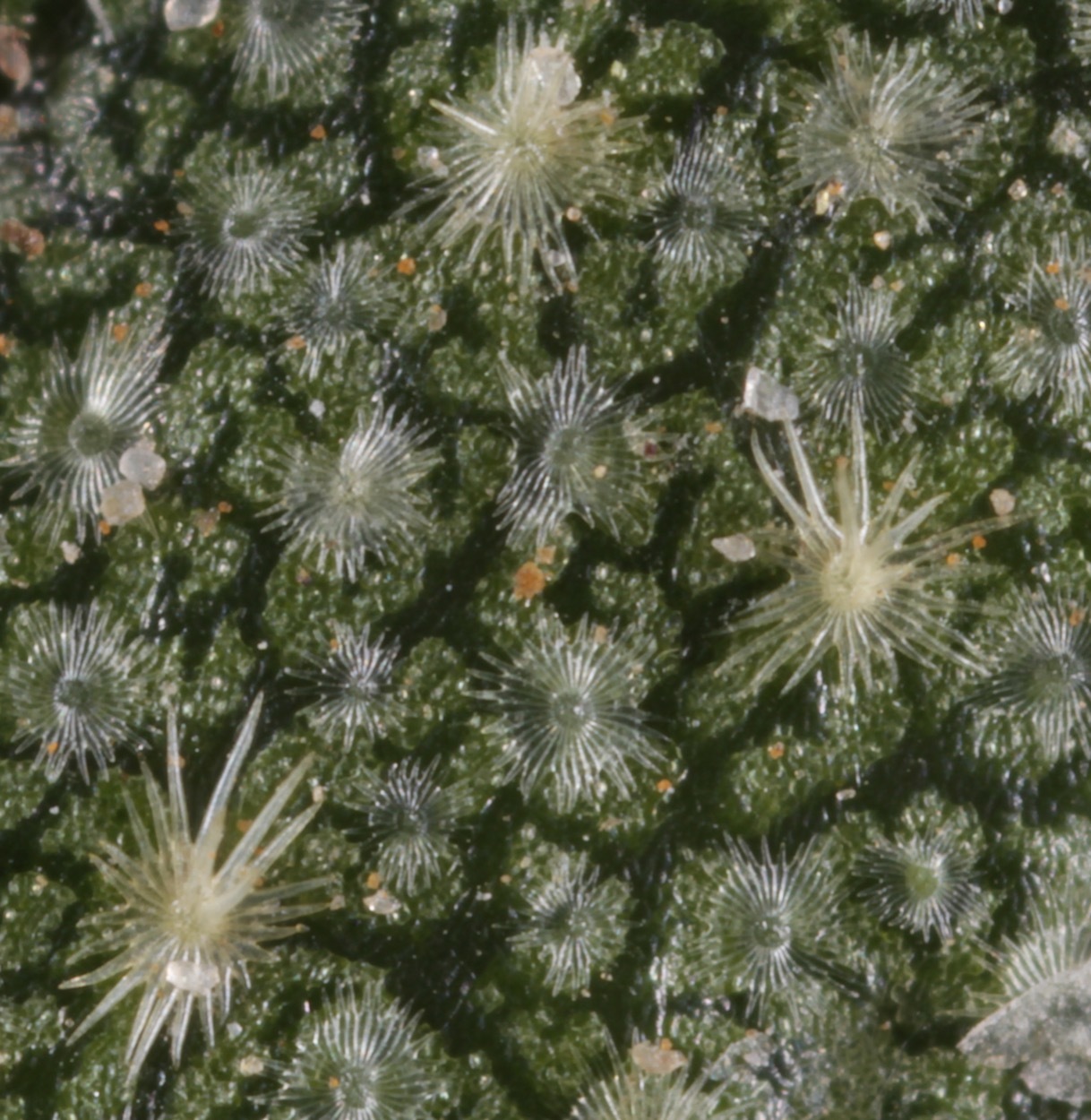
Malvella leprosa hairs from Lubbock.
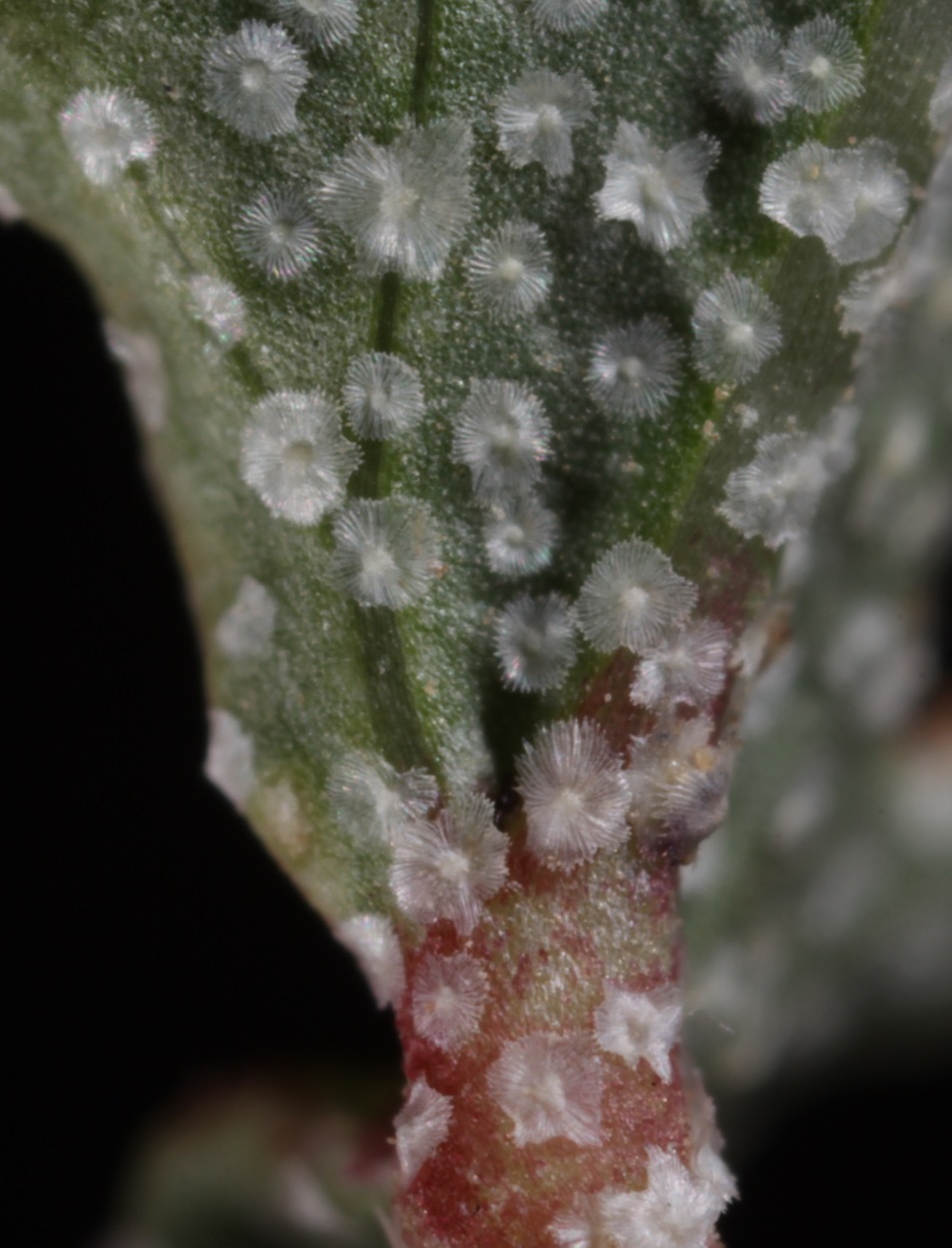
Malvella sagittifolia hairs from Alpine.
This summary only reflects the types and the US observations on iNaturalist and may need other locations to fully understand the diversity, but this is a good starting point. Now, for the examples.
Malvella leprosa
The shaggy, stellate hair form. This is what was refered to as M. hederacea or M. leprosa var. hederacea. A texas observation can be found here and here.
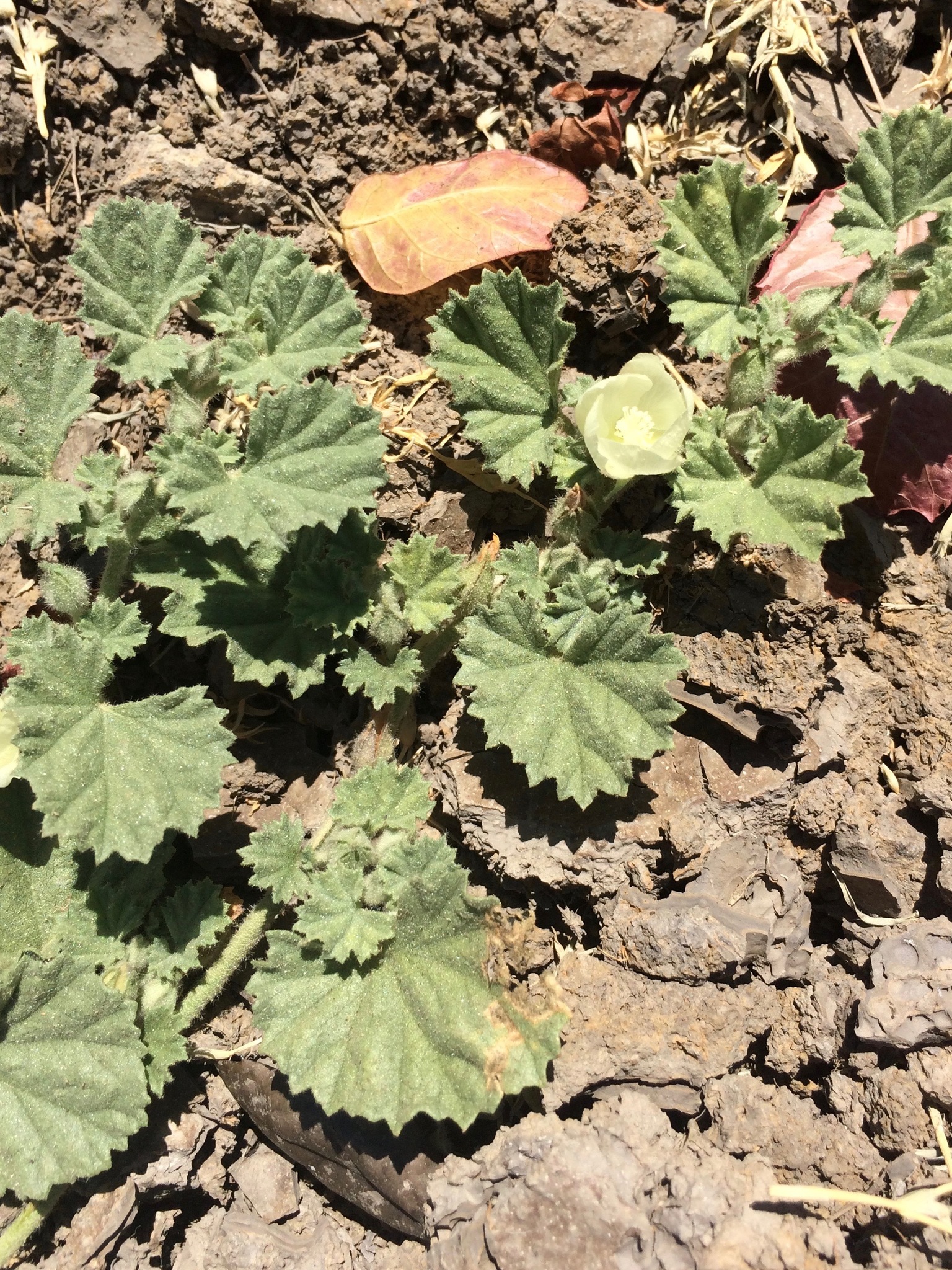
Photo credit lazarus: https://www.inaturalist.org/observations/9484575
Malvella leprosa
Stellate and sub-lepidote hairs.
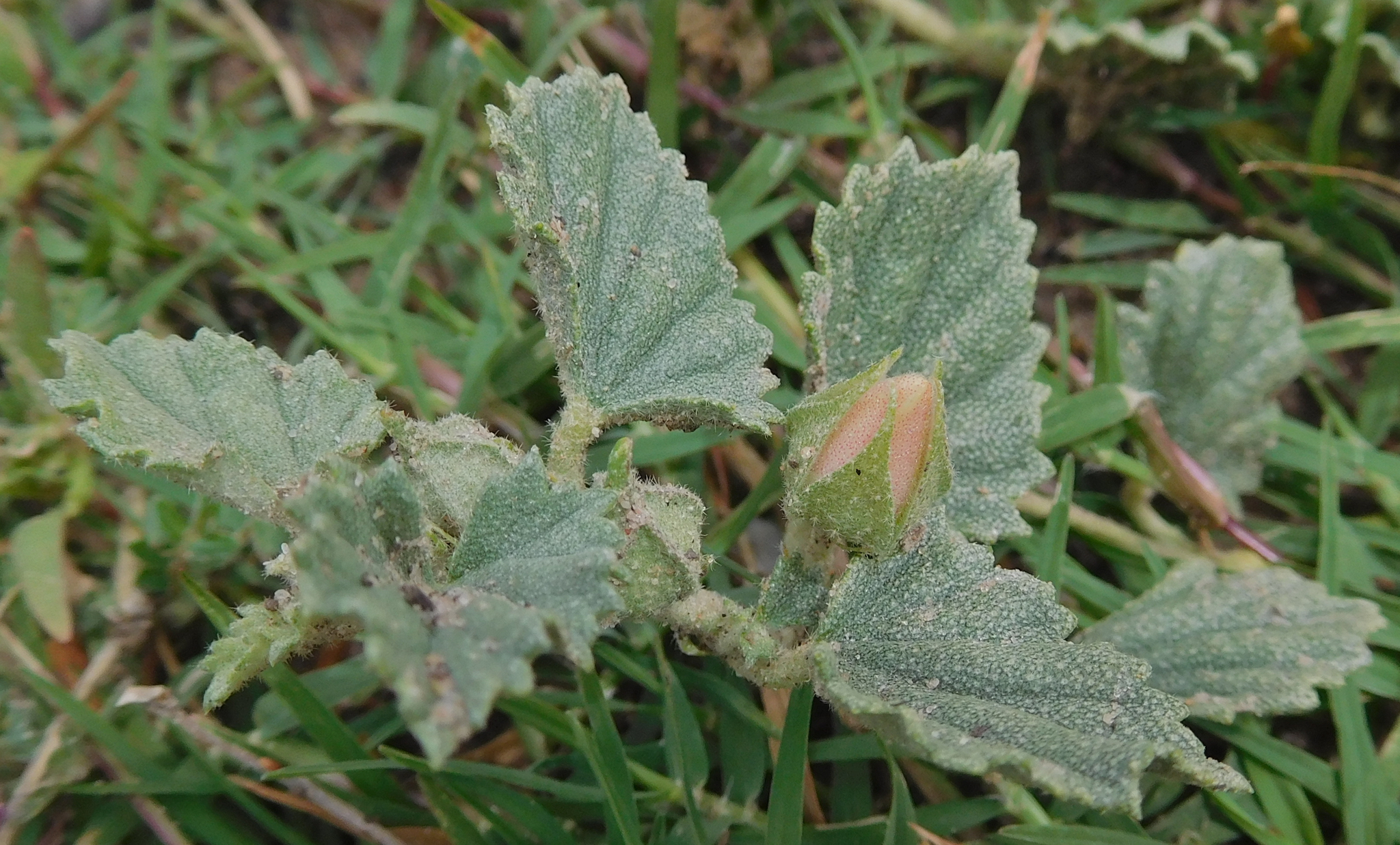
Photo credit Ellen Hildebrandt: https://www.inaturalist.org/observations/3200992
Malvella leprosa
Only sub-lepidote hairs.
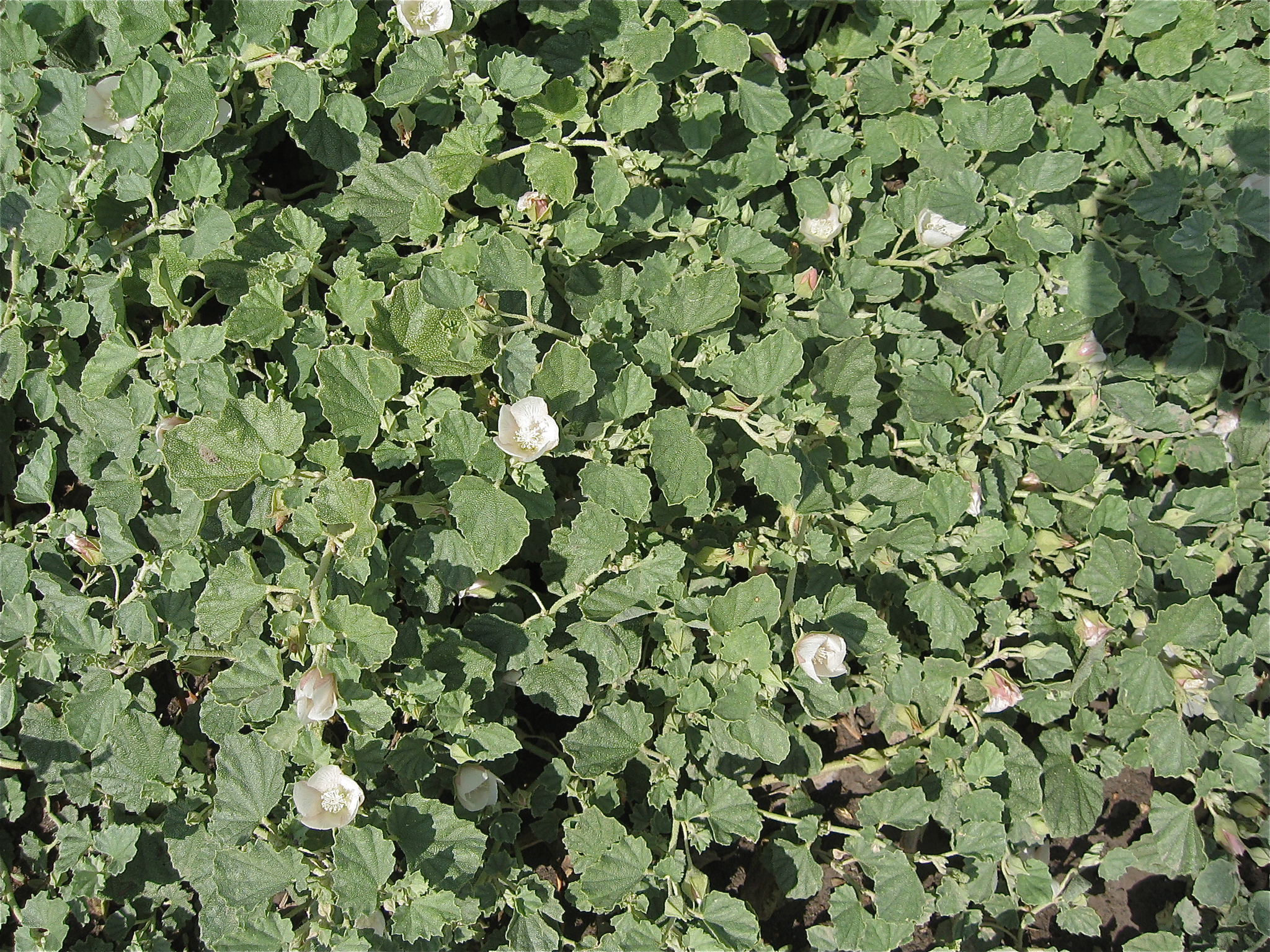
Photo credit Ellen Hildebrandt: https://www.inaturalist.org/observations/2451273
Malvella intermediate?

Photo credit Ellen Hildebrandt: https://www.inaturalist.org/observations/3629472
Malvella intermediate?
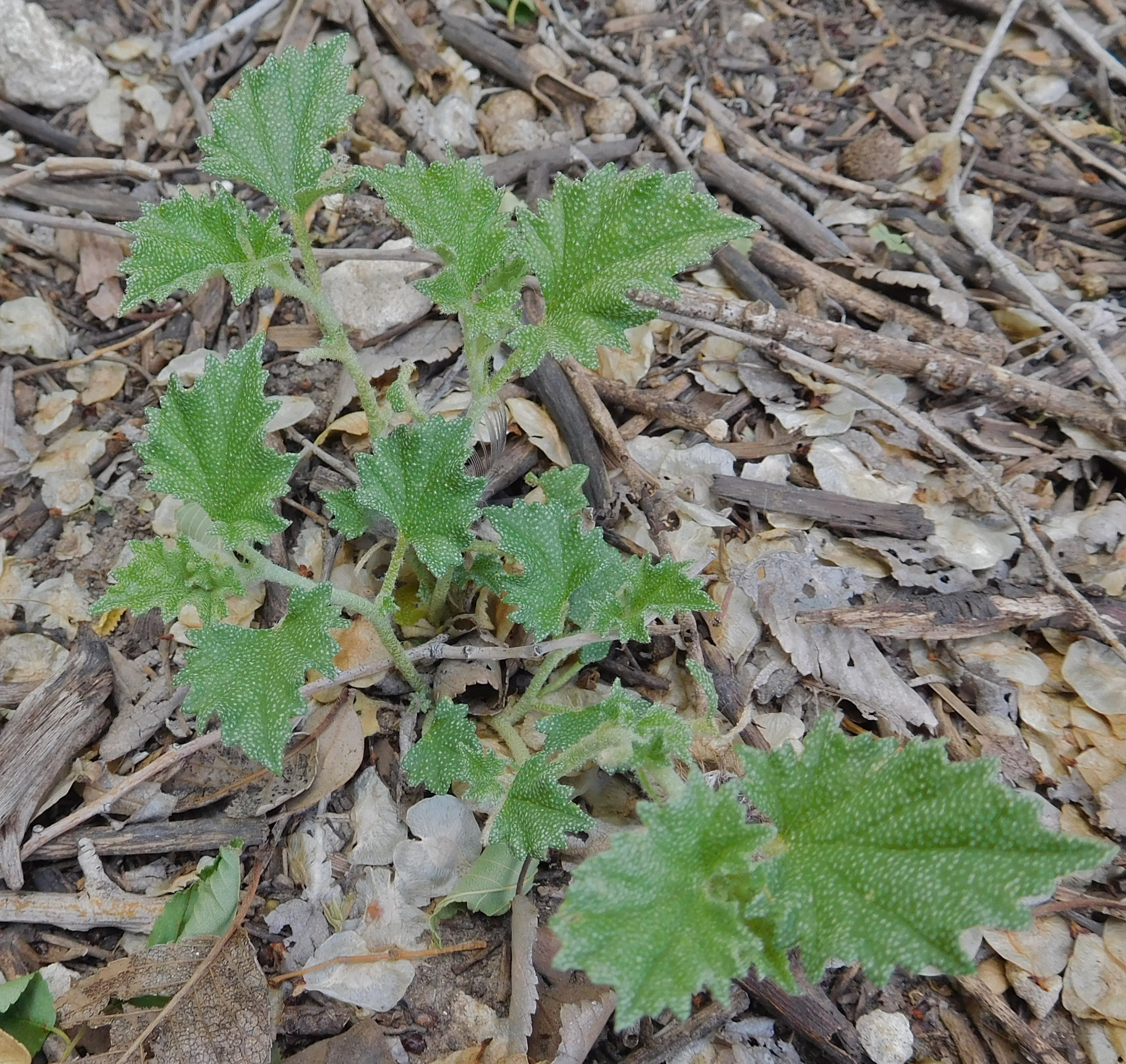
Photo credit Ellen Hildebrandt: https://www.inaturalist.org/observations/3100663
Malvella lepidota?
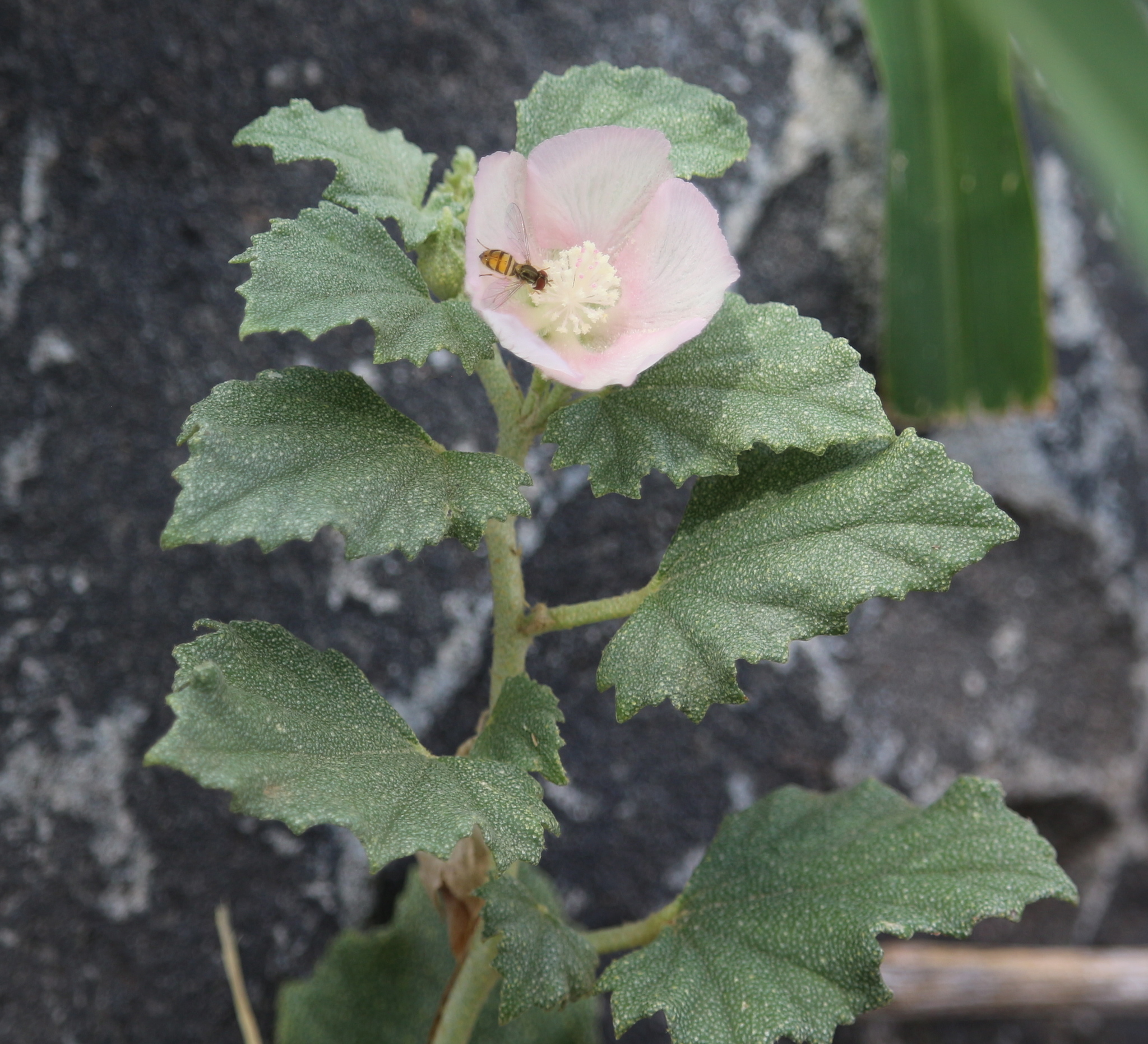
Photo credit Lena Zappia: https://www.inaturalist.org/observations/6738322
Malvella lepidota
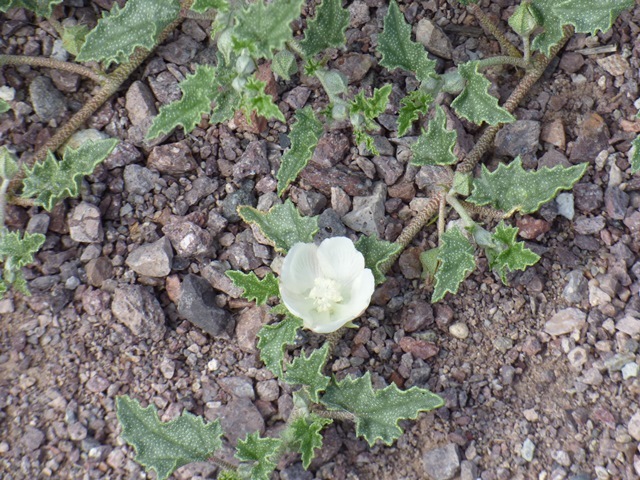
Photo credit amawal: https://www.inaturalist.org/observations/6892282
Malvella lepidota

Photo credit Patrick Alexander: https://www.inaturalist.org/observations/9300021
Malvella sagittifolia
Lepidote hairs. On the leaves, lobes on the triangular appendage coming out from the base.

Photo credit Eric Keith: https://www.inaturalist.org/observations/4936183
Malvella sagittifolia
Lepidote hairs. On the leaves, no lobing on the triangular appendage coming out from the base.
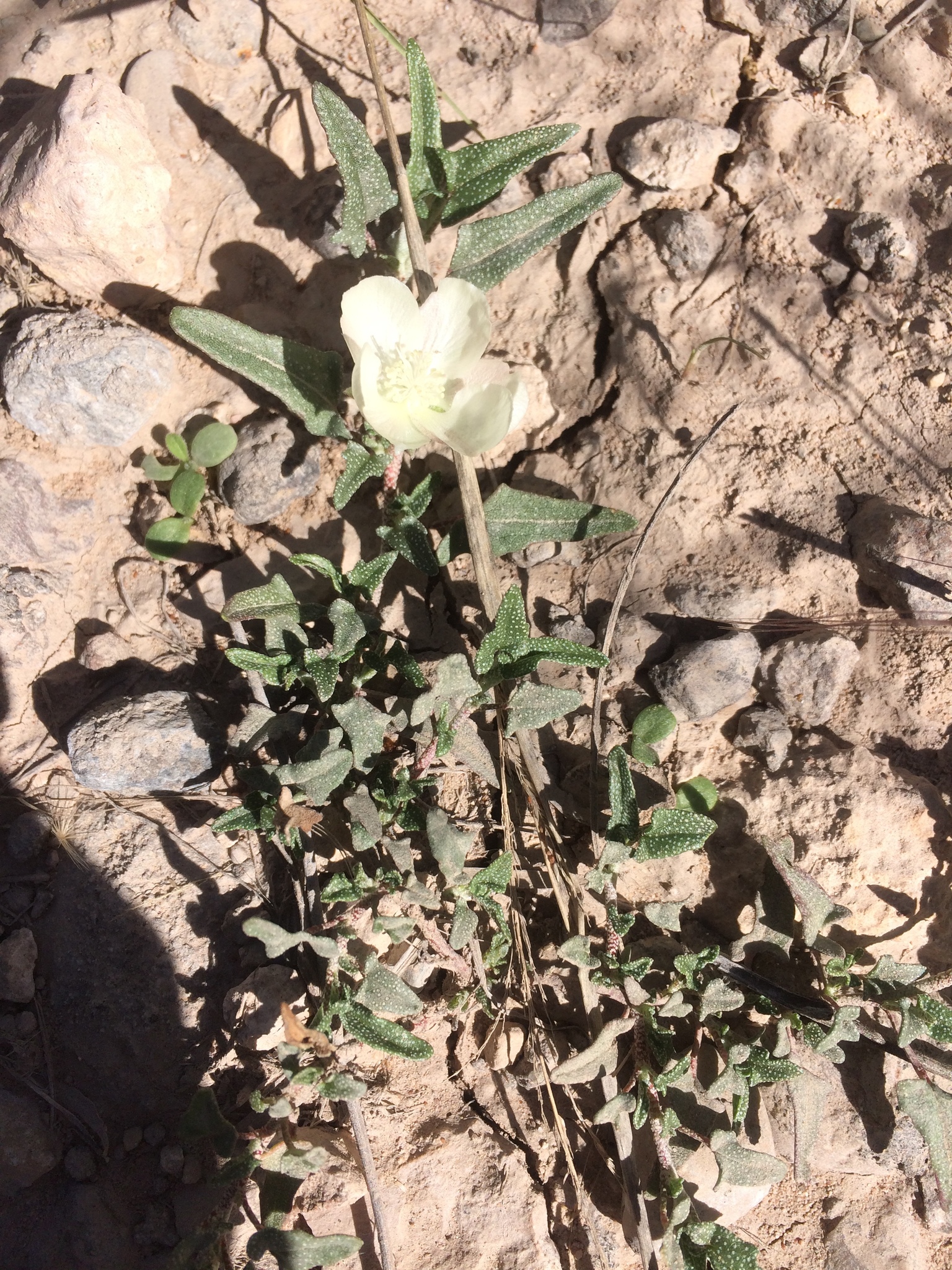
Photo credit Nathan Taylor: https://www.inaturalist.org/observations/8558418
Another thing that complicates identification is that the leaves of Malvella are oblique (asymmetric). If we are supposed to know if a leaf is wider than long, it should be important to know where to measure from. However, knowing exactly where the width is supposed to be measured from (perpendicular to the petiole or at an angle to the petiole) is not clear.
Links to types
M. leprosa (type)
M. hederacea (type)
M. lepidota (Isotype)
M. sagittifolia (Holotype)
M. leprosa (similar to type)




Comentarios
@aspidoscelis I'd particularly like your input here. The characteristics pretty closely match FNA and other references but fits few of the M. leprosa photos of living plants on SEINet (not necessarily the specimens, though). The line between the two species is quite blurry if using leaf shape, but quite distinct using hairs.
Greetings, Nathan,
I have a suspicion that we're looking at two separate trichome characters here: first, are the rays of the trichomes confluent (=lepidote) or distinct (=stellate); second, are the rays of the trichomes parallel to the surface of the leaf (≈lepidote?) or spreading away from the surface of the leaf (≈stellate?). The latter two possibilities only exist if the rays are distinct. Talking just about the dominant state of the trichomes and ignoring "mostly this but sometimes that" details, we have three character states: 1) rays confluent; 2) rays distinct and parallel to the surface of the leaf; 3) rays distinct and spreading away from the surface of the leaf. Matching that onto some observations:
1: https://www.inaturalist.org/observations/6711688
2: https://www.inaturalist.org/observations/3200992
3: https://www.inaturalist.org/observations/5880683
This genus always gives me a headache, but that's usually on the distinction between Malvella lepidota & Malvella sagittifolia, rather than involving Malvella leprosa, which I rarely see around here. That said, here's my best guess: Malvella lepidota & Malvella sagittifolia: 1; Malvella leprosa: 2 or 3. I think the arrangement you're leaning towards is more like: Malvella sagittifolia: 1; Malvella lepidota: 2; Malvella leprosa: 3.
I think looking at calyces might be useful. It's looking to me in brief inspection as though adaxial leaf pubescence forms 2 and 3 both correspond with sepal pubescence of form 3, while 1 on adaxial leaf surfaces corresponds with 1 on sepals. I also think that pubescence form 2 on adaxial leaf surfaces corresponds with 3 on abaxial leaf surfaces, while 1 adaxial means 1 abaxial and 3 adaxial means 3 abaxial.
Regards,
Patrick
Adding on habitat & abundance, my impression in southern NM is:
Malvella lepidota: pubescence form 1 adaxial, abaxial, and sepals; leaves intermediate in width, relatively many teeth; low clay flats but not riparian (e.g., lots of tobosa); about 95% of the plants I see.
Malvella sagittifolia: pubescence form 1 adaxial, abaxial, and sepals; leaves narrow, somewhere about 1-3 teeth towards the base; low clay flats but not riparian; about 4% of the plants I see.
Malvella leprosa: pubescence form 2 adaxial, 3 abaxial and on sepals; leaves wide, many teeth; floodplains (basically, along the Rio Grande; e.g., with Cressa, Heliotropium curassavicum, Distichlis, Sesuvium, Anemopsis nearby); <1% of the plants I see.
I don't think I've seen plants with pubescence form 3 on the adaxial leaf surfaces in person, though I'm seeing that in some of the Texas observations IDed as Malvella leprosa and about all of the California observations where Malvella leprosa is apparently the only species known in the area.
Hi Patrick,
Thanks for the information. FNA says that in M. lepidota, the abaxial hairs are densely stellate. So, I think it's interpretation of both form 1 and 2 are M. lepidota. That being said, I have seen the two different forms of the lepidota-like plants you describe. Also, the ones with stellate hairs abaxially seem to have broader leaves (but not quite as broad as those of E. leprosa on average). Those plants are a bit difficult to interpret, though it seems to me that FNA's interpretation of these are of M. lepidota. I wonder if these could be hybrids. I wish there were more photos of the sepals here, but I have noticed how the pubescence does seem to correspond to that of the abaxial sides of the leaves and stems. Malvella is quite confusing. Prior to this, I have looked at the keys and the plants out here and pretty much gave up on it at least twice, which is not really what I expect in a genus with so few species.
Then again, FNA also says that the calyces of M. lepidota are lepidote, while those of M. leprosa have mixed hairs. Also, the placate sepal characteristic seems at least inconsistent, with form 3 sometimes having it, sometimes not.
As to the hairs, I hadn't looked close enough to notice the difference between the lepidote and sublepidote hairs. It's a good point, though I am still not entirely sure how to interpret it. The plants that are obviously M. leprosa are so distinctive and different from even the plants that seem intermediate.
I'm getting the impression that we have four things that we're trying to stuff into three names.
So it might be a question of whether you think it's more reasonable to see these two:
https://www.inaturalist.org/observations/292549
https://www.inaturalist.org/observations/5880683
as conspecific, with this a separate species:
https://www.inaturalist.org/observations/6711688
Or whether you think it's more reasonable to see these two as conspecific:
https://www.inaturalist.org/observations/6711688
https://www.inaturalist.org/observations/292549
With this a separate species:
https://www.inaturalist.org/observations/5880683
The first of those two options is how I've been viewing the situation, correctly or not. It could be that the right answer is that these are three separate taxa (plus sagittifolia makes four).
I'm really not comfortable with the idea that these two are the same thing, though:
https://www.inaturalist.org/observations/6711688
https://www.inaturalist.org/observations/292549
If we call 292549 Malvella lepidota, then I feel like I need to call 6711688 Malvella sagittifolia. Which perhaps is right, I don't know.
For what it's worth, this is the only one in Texas that I would have called Malvella lepidota:
https://www.inaturalist.org/observations/8400346
That's certainly the impression I'm getting. At the very least, it seems like hybridization is common.
I guess that is the questing. I know I do have a tendency to focus on hairs over leaves because they usually seem a little more stable across growth stages, but there is a substantial difference between the odd morphotype and the morphotype that represents M. leprosa s.s. Honestly, I do think it's different, whether hybrid or altogether different species, I'm not sure. I guess I'm going to have to keep an eye out for it from now on and try to get more information.
As for M. sagittifolia, I haven't had any trouble distinguishing it from M. lepidota so far (after your correction on my obviously incorrectly identified observation). I know M. sagittifolia has been treated as a variety of M. lepidota in the past, but from what I have seen, it's relatively distinct. I'm sure you have a lot more experience with that than I, though. FYI, the type (technically an Isotype) is pretty clearly in line with what you have been calling M. lepidota, so M. lepidota s.s. can't really be sunk into M. sagittifolia (it would be the other way around and it still wouldn't resolve this other entity).
For reference, here is an isotype of M. leprosa var. sagittifolia (M. sagittifolia) and another isotype of M. lepidota.
Also, you might check out Fryxell 1974 (The North American Malvellas (Malvaceae); The Southwestern Naturalist 19(1):97-103) and Clement 1957 (Studies in Sida (Malvaceae); Contributions from the Gray Herbarium of Harvard University 180:5-91). The specimens at NMC were annotated by Fryxell in the 1970s, so I think my understanding of the genus is in line with that of Fryxell's 1974 treatment. I haven't really looked at the FNA treatment before, though.
Nice types! I was poking around a bit for types, but I didn't get as far as you. :-)
Looks like the type of Malvella leprosa is kind of a lost cause to find online, but there might be a type out there for Malvella leprosa var. hederacea (Sida leprosa var. hederacea sensu Clement) and that would be interesting. Clement makes a distinction between Sida leprosa var. leprosa and Sida leprosa var. hederacea that might correspond with the variation we're looking at in plants I would have all called Malvella leprosa. Clement, though, thought he was distinguishing between a basically North American thing (var. hederacea) and a basically South American thing (var. leprosa)... Fryxell said that the characters Clement was using don't really correspond with that geographic distinction...
I've seen Fryxell, but not Clements. It seems that our mystery form falls under M. leprosa var. leprosa while the California plants would fall under M. leprosa var. hederacea according to Clements. Looks like it's time to do more research. I think I'll take a look at the references in Fyxell (1974) if I get the chance. Out of curiosity, were you able to find a large file of a type of var. hederacea? Also, it Fryxell wrote FNA as well.
So, just to be clear, you would consider this, this, and this to be M. leprosa? I don't know, I keep seeing somewhat of a continuum in leaf-shape and am not really sold on it being a stable character. That being said, I'm not at all sure what to make of this observation.
I just got a look at the type of M. leprosa. It looks like my interpretation doesn't have a leg to stand on as it has only sub-lepidote hairs with no stellate hairs. I guess I'm going to have to try to make sense out of these leaf shapes. It kind of surprises me that M. herbacea was synonymized as that one seems like the most distinctive out of all the species.
Ok. I essentially summarized all I have in the journal entry above.
I guess I'll have to re-read the entry.
Agregar un comentario